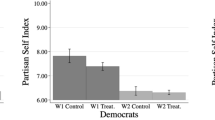Conclusion
This note has investigated the necessary conditions for the existence of Ostrogorski's Paradox, and it showed that the paradox depends on the sizes of the groups taking each possible set of stands on the salient issues. By revising its positions on relevant issues, the majority party can avert the paradox. With increased emphasis on single-issue voting observed in the United States and other Western democracies, the analysis of the paradox should guide the understanding of parties' responses to coalition formation processes among special interest groups. Indeed, the Apex conditions characterizing the paradox provide clues as to the strategy to be followed by the majority party in selecting its platform: the party should generally follow positions advocated by the largest group while presenting a coalition of all other groups.
Similar content being viewed by others
References
Daudt, H.: 1977, ‘The Political Future of the Welfare State’, Netherlands Journal of Sociology 13, 89–107.
Daudt, H. and Rae, D. W.: 1978, ‘Social Contract and the Limits of Majority Rules’, in P. Birnbaum, J. Lively, and G. Parry (eds.), Democracy, Consensus, and Social Conflict, Sage, Beverly Hills and London, pp. 355–367.
Davis, O., Hinich, M. J., and Ordeshook, P. C.: 1970, ‘An Expository Development of a Mathematical Model of the Electoral Process’, American Political Science Review 64, 426–448.
Horowitz, A. D.: 1973, ‘The Cooperative Bargaining Set for Cooperative N-Person Games’, Journal of Mathematical Psychology 10, 265–289.
Horowitz, A. D. and Rapoport, Am.: 1974, ‘Test of the Kernel and Two Bargaining Set Models in Four- or Five-Person Games’, in Am. Rapoport (ed.), Game Theory as a Theory of Conflict Resolution, D. Reidel, Dordrecht.
Rae, D,W. and Daudt, H.: 1976, ‘The Ostrogorski Paradox: A Peculiarity of Compound Majority Decision’, European Journal of Political Research 4, pp. 391–398.
Author information
Authors and Affiliations
Additional information
The helpful comments of Howard Tamashiro on an earliar draft of this paper are greatfully acknowledge.
Rights and permissions
About this article
Cite this article
Shelley, F.M. Notes on Ostrogorski's paradox. Theor Decis 17, 267–273 (1994). https://doi.org/10.1007/BF00132611
Issue Date:
DOI: https://doi.org/10.1007/BF00132611




